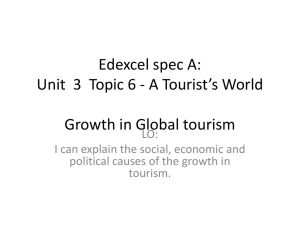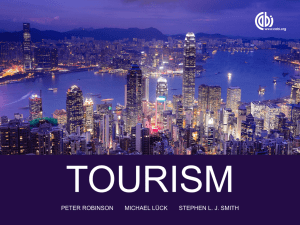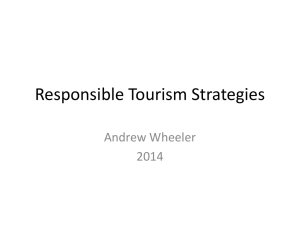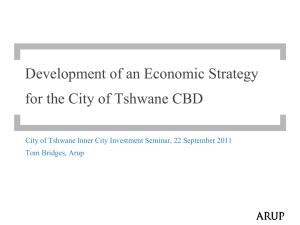Tourism Sales - Springfield - Clark County Chamber of Commerce
advertisement
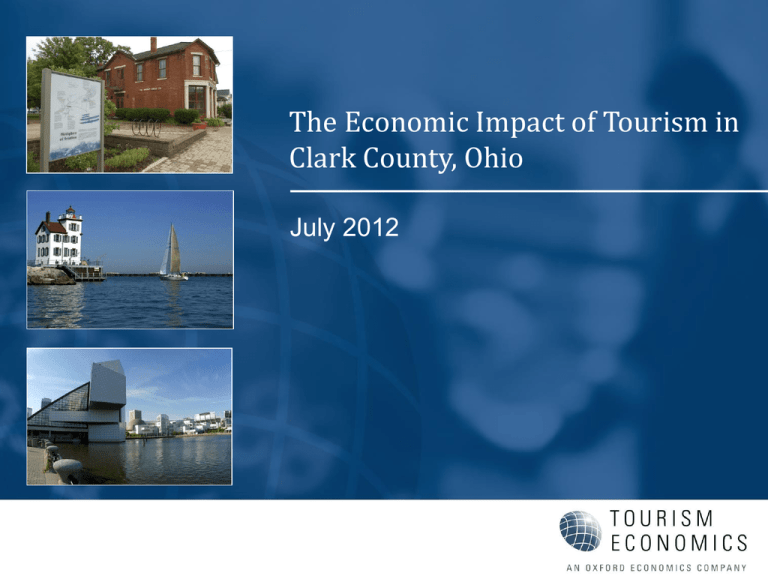
The Economic Impact of Tourism in Clark County, Ohio July 2012 Clark County Tourism Summary Total Tourism Impact Clark County, Ohio Sales $326.2 million Wages $79.8 million Taxes $41.8 million Employment Clark County 2 4,271 Overview Tourism is an integral and driving component of the Clark County economy, sustaining 8.9% of salaried employment. Visitors to Clark County generated business sales of $326 million, directly and indirectly, in 2011. Tourism is a diverse composite of economic activities, including transportation, recreation, retail, lodging, and food & beverage sectors. 3 State Summary Key results More than 440,000 jobs, with associated income of $10.5 billion, were sustained by visitors to Ohio last year. These jobs represent 8.7% of total employment in Ohio – 1 in every 15.5 jobs in Ohio is sustained by the tourism economy. Including indirect and induced impacts, tourism in Ohio generated $2.7 billion in state and local taxes and $2.6 billion in Federal taxes last year. In the absence of the state and local taxes generated by tourism, each Ohio household would need to pay $600 to maintain the current level of government services. 5 Key themes for 2011 The Ohio visitor economy continued to expand in 2011. Visitor spending within Ohio rose 6.5% after a 7.4% increase in 2010. ■ Visitor volumes rose for a second straight year, 181.5 million people travelled in Ohio in 2011 – a new high. ■ Growth in overnight visitation remains strong. Domestic overnight visitation grew 4.7% buoyed by strong hotel room demand growth of 6.4% in 2011. ■ Per trip spending rose as gas prices rose and hotels and other tourism providers start to recoup recessionary price cuts. Visitor spending of $26.3 billion generated $40 billion in total business sales in 2011 as tourism dollars flowed through the Ohio economy. Tourism taxes grew faster than overall state tax receipts. 6 Growth in tourism sales The tourism industry surpassed pre-recession highs. Total Tourism Sales US$ Billions $41 $40.3 $40 6% $39.2 $39 $38.3 4% $38.2 $38 2% $36.5 $37 $36 $35 8% 0% $35.8 -2% $34.9 -4% $34 -6% $33 -8% $32 -10% 2005 2006 2007 TOTAL Source : Tourism Economics 7 2008 2009 2010 % Change 2011 Visitor spending increasing 6.5% and total sales (including indirect and induced impacts) increasing 5.5%. Ohio registered over $40 billion in total tourism sales in 2011. Visitor spending by sector Higher gas prices in 2011 increased the transportation share of tourism spending to 31%, just short of the 2008 high. Visitor Spending By Sector Lodging 10% F&B 26% Air 2% Retail 15% Trans 31% Rec 16% Source : Tourism Economics 8 Food & beverage spending ranks second, capturing 26% of visitor spending. The growth in overnight stays along with increasing room rates increased the share of spending on accommodations to 10%. Total tourism sales Tourism Sales (US$ Million) Direct Agriculture, Fishing, Mining Construction and Utilities Manufacturing Wholesale Trade Air Transport 624.1 Other Transport 2,758.8 Retail Trade 3,846.1 Gasoline Stations 4,569.9 Communications Finance, Insurance and Real Estate 972.4 Business Services Education and Health Care Recreation and Entertainment 4,074.2 Business Day Lodging 2,762.4 Food & Beverage 6,727.6 Personal Services Government TOTAL 26,335.5 * Direct sales include cost of goods sold for retail sectors 9 Indirect 189.9 445.8 1,612.7 53.7 10.9 451.3 215.1 14.7 457.4 1,324.1 1,796.9 5.9 113.3 42.7 116.1 175.1 179.5 7,205.1 Induced 69.5 181.7 743.7 39.5 9.9 191.9 868.5 54.5 197.4 904.4 513.8 1,254.7 98.0 34.9 330.9 299.5 1,010.1 6,802.6 Total 259.4 627.5 2,356.4 93.2 644.9 3,402.0 4,929.7 4,639.1 654.8 3,200.8 2,310.6 1,260.6 4,285.5 2,840.0 7,174.6 474.6 1,189.6 40,343.3 2011 direct sales growth 0.0% 0.0% 0.0% 0.0% 2.6% 6.8% 4.6% 14.6% 0.0% 5.7% 0.0% 0.0% 2.9% 9.4% 3.9% 0.0% 0.0% 6.5% Total tourism sales 10 $ million 8,000 Induced 7,000 Indirect 6,000 Direct 5,000 4,000 3,000 2,000 1,000 Comm. Gov. Education Bus. Services Manu Lodging FIRE Other Transp Recreation Gas 0 Retail Trade Sectors that serve the tourism industry, like business services, gain as suppliers to a dynamic industry. Tourism Sales by Industry F&B All business sectors of the Ohio economy benefit from tourism activity directly and/or indirectly. How visitor spending generates impact • Travelers create direct economic value within a discreet group of sectors (e.g. recreation, transportation). This supports a relative proportion of jobs, wages, taxes, and GDP within each sector. • Each directly affected sector also purchases goods and services as inputs (e.g. food wholesalers, utilities) into production. These impacts are called indirect impacts. • 11 Lastly, the induced impact is generated when employees whose incomes are generated either directly or indirectly by tourism, spend those incomes in the state economy. Total tourism employment Tourism Economy Employment Direct Agriculture, Fishing, Mining Construction and Utilities Manufacturing Wholesale Trade Air Transport Other Transport Retail Trade Gasoline Stations Communications Finance, Insurance and Real Estate Business Services Education and Health Care Recreation and Entertainment Lodging Food & Beverage Personal Services Government TOTAL 12 3,034 29,645 43,748 11,914 6,981 58,690 37,216 136,346 327,574 Indirect Induced 2,443 1,692 3,968 302 44 4,197 3,173 187 2,052 8,596 16,982 91 3,034 611 2,349 2,336 921 52,980 851 350 1,652 219 40 1,559 12,700 681 707 5,111 5,209 15,220 1,855 478 6,605 5,564 518 59,317 Total 3,295 2,041 5,620 521 3,118 35,402 59,622 12,781 2,759 20,688 22,191 15,311 63,579 38,305 145,300 7,900 1,439 439,872 The tourism sector directly and indirectly supported 440,000 jobs, or 8.7% of all employment in Ohio last year. Tourism personal income Tourism Labor Income (Compensation) (US$ Million) Direct Agriculture, Fishing, Mining Construction and Utilities Manufacturing Wholesale Trade Air Transport Other Transport Retail Trade Gasoline Stations Communications Finance, Insurance and Real Estate Business Services Education and Health Care Recreation and Entertainment Business Lodging Food & Beverage Personal Services Government TOTAL 13 Day 195.5 815.3 844.1 268.0 158.8 1,220.6 899.3 2,074.5 6,476.1 Indirect 34 119.9 219.9 19.6 3.2 204.3 82.7 4.4 110.2 304.1 758.6 2.8 46.0 14.5 34.7 64.9 48.3 2,071.5 Induced 15 41.8 100.0 14.2 2.9 74.9 330.2 16.0 40.3 222.2 226.4 617.6 36.6 11.2 97.8 118.8 26.0 1,991.5 Total 48.1 161.7 319.8 33.8 201.6 1,094.5 1,257.0 288.3 150.5 685.1 985.0 620.4 1,303.2 925.0 2,207.0 183.7 74.3 10,539.1 Tourism tax generation Tourism-Generated Taxes (US$ Million) Total 2011 growth Federal Taxes Corporate Indirect Business Personal Income Social Security 2,581.8 464.9 236.1 789.3 1,091.5 3.8% State Taxes Corporate Personal Income Sales State Social Security Excise and Fees 1,603.2 395.9 319.3 758.8 57.7 71.4 5.3% Local Taxes Business Personal Income Sales Property Admissions Lodging Other Taxes and Fees TOTAL 1,116.0 Day 31.9 138.0 724.2 23.6 131.8 66.4 5,301.1 4.4% 14 Taxes of $5.3 billion were directly and indirectly generated by tourism in 2011. State and local taxes alone tallied $2.7 billion. 4.4% Each household in Ohio would need to be taxed an additional $600 per year to replace the tourism taxes received by state and local governments. Regional Summary Tourism Sales Tourism Sales by Region Cleveland, Cincinnati and Columbus are anchors which influence the distribution of the tourism economy across Ohio. Central 23% Southwest 24% ■Including Cincinnati ■Including Columbus ■Including Toledo ■Including Cleveland Northwest 13% ■Including Hocking Hills Southeast 4% Northeast 36% 16 Relative to the size of their economies, tourism is still of significant importance to the Northwest and Southeast regions. Tourism Employment Tourism Employment by Region 17 Southeast Northwest ■Day Central ■Business Southwest Induced Indirect Direct Northeast Thousands 180 160 140 120 100 80 60 40 20 0 Tourism Wages Tourism Earnings by Region $ Billions 4.5 4.0 3.5 3.0 2.5 2.0 1.5 1.0 0.5 0.0 18 Southeast Northwest Central Southwest Northeast Induced Indirect Direct Southwest Ohio Detail Southwest Ohio Tourism Impact Total Tourism Impact* County Adams Sales Wages 475 Brown 44,400,609 766 11,063,749 5,901,276 Butler 900,231,839 11,701 233,140,534 115,230,020 45,692,272 922 11,559,575 5,838,281 Clark 326,214,817 4,271 79,835,086 41,774,782 Clermont 534,349,774 6,553 126,161,202 69,313,211 Clinton 81,469,282 851 20,471,176 10,465,197 Darke 63,338,113 1,426 16,773,241 8,112,104 Fayette 72,872,517 824 19,618,634 9,346,771 Greene 471,656,731 6,471 125,349,042 60,735,388 Hamilton 4,260,111,946 41,357 1,118,386,883 571,548,379 Highland 43,372,465 1,027 11,590,608 5,548,118 211,558,458 2,884 58,949,658 27,176,183 1,652,101,610 19,191 413,842,797 211,690,859 Preble 52,847,190 1,147 15,860,359 6,769,011 Warren 993,075,833 10,657 260,904,908 127,571,918 9,782,367,962 110,524 2,530,973,601 1,280,741,045 Miami Montgomery Southwest Ohio $ 7,466,149 Taxes 29,074,506 Champaign $ Employment $ 3,719,547 * Includes Direct, Indirect and Induced impacts. Sales includes cost of goods sold for retail sectors. 20 Southwest Ohio Tourism Sales Total Tourism Sales: $9.8 billion Total tourism sales tallied $9.8 billion in Southwest Ohio in 2011, up 5.1% from 2010. Warren Montgomery Butler Clermont Greene Clark Hamilton 21 Miami Clinton Fayette Darke Preble Adams Highland Brown Champaign Southwest Ohio Tourism Employment Tourism Share of Total Employment At nearly 9% of all employment, tourism is an important part of the Southwest Ohio economy. 16% Direct Total State Average (Total) 14% 12% 10% 8% 6% 4% 2% 22 Warren Preble Montgomery Miami Highland Hamilton Greene Fayette Darke Clinton Clermont Clark Champaign Butler Brown Adams 0% 23 Wholesale Trade Ag. & Mining Government 400 Communications 500 Const. & Utilities Personal Serv. Manufacturing Educ. & Health Fin., Ins. & RE Lodging Business Serv. Transportation Rec. & Ent. Retail Trade Food & Bev Southwest Ohio Tourism Wages Tourism Earnings by Industry $ Millions 600 Induced Indirect Direct 300 200 100 0 Clark County Detail Tourism Sales Trend Recent Trend in Tourism Sales (Output) 2009 2010 2011 Clark County sales trend: Sales volume (US$ Million) Sales growth (% year) 306.8 312.0 326.2 -6.2% 1.7% 4.6% -8.6% 7.4% 5.1% -8.8% 6.9% 5.6% Sales trend for the wider region and state: Southwest Ohio sales growth (% year) ■Business ■Day Ohio sales growth (% year) 25 Tourism Sales Tourism Sales (Output) (US$) Direct* Indirect Induced Total Agriculture, Fishing, Mining - 1,534,450 563,583 2,098,033 Construction and Utilities - 3,602,217 1,473,821 5,076,038 Manufacturing - 13,031,454 6,033,619 19,065,074 Wholesale Trade - 433,940 320,150 754,090 Transportation 20,525,209 3,734,421 1,637,216 25,896,846 Retail Trade 67,798,908 1,857,521 7,488,067 77,144,496 3,695,941 1,601,301 5,297,242 10,699,100 7,337,550 42,874,103 Communications - Finance, Insurance and Real Estate 24,837,453 Business Services - 14,519,426 4,168,438 18,687,863 Education and Health Care - 47,599 10,179,431 10,227,030 Recreation and Entertainment 21,820,666 915,328 795,134 23,531,128 Lodging 19,770,036 344,794 283,154 20,397,984 Food & Beverage 58,050,832 938,515 2,684,689 61,674,036 - 1,415,286 ■Day 2,429,621 3,844,907 - 1,450,621 8,195,326 9,645,946 58,220,613 55,191,101 326,214,817 Personal Services Government TOTAL ■Business 212,803,104 % change 09 - 10 2.2% 1.0% 0.7% 1.7% % change 10 - 11 5.4% 2.1% 3.8% 4.6% * Direct sales includes cost of goods sold for retail sectors 26 Visitors generated $326 million in business activity in Clark County in 2011. In addition to direct tourism industries, the manufacturing sector and business services sectors are important tourism beneficiaries as suppliers. 27 Wholesale Trade Ag. & Mining Personal Serv. Const. & Utilities $ Million 90 80 70 60 50 40 30 20 10 0 Communications Government Educ. & Health Business Serv. Manufacturing Lodging Rec. and Ent. Transportation Fin., Ins. & RE Food & Bev. Retail Trade Tourism Sales Tourism Sales by Industry Induced Indirect Direct Tourism Employment Tourism Employment Total Induced Indirect Direct Agriculture, Fishing, Mining Construction and Utilities - 24 16 8 3 33 20 Manufacturing - 39 16 55 Wholesale Trade - 3 2 5 Transportation 269 41 16 326 Retail Trade 528 32 129 689 Communications - 20 7 26 Finance, Insurance and Real Estate 177 82 49 308 Business Services - 167 51 219 Education and Health Care - 1 148 149 Recreation and Entertainment 500 29 18 547 Lodging 320 6 5 331 Food & Beverage 1,387 23 64 1,474 Personal Services - 23 54 76 Government - 9 5 14 515 575 4,271 TOTAL 3,182 % change 09 - 10 -5.0% -4.6% -4.6% -4.9% % change 10 - 11 -0.6% -0.5% -0.9% -0.7% Tourism supports 1 in every 11 salaried jobs in Clark County. 28 29 Wholesale Trade Government Const. & Utilities Communications Thousands 1.6 1.4 1.2 1.0 0.8 0.6 0.4 0.2 0.0 Ag. & Mining Manufacturing Personal Serv. Educ. & Health Business Serv. Fin., Ins. & RE Transportation Lodging Rec. and Ent. Retail Trade Food & Bev. Tourism Employment Tourism Employment by Industry Induced Indirect Direct Tourism Wages Tourism Income (Compensation) (US$) Direct Indirect Induced Agriculture, Fishing, Mining Construction and Utilities - 256,485 905,957 111,537 315,361 368,023 1,221,318 Manufacturing - 1,666,261 757,749 2,424,010 Wholesale Trade - 148,307 107,770 256,076 Transportation 5,999,314 1,571,205 588,911 8,159,430 Retail Trade 8,475,922 658,928 2,621,083 11,755,933 833,435 304,805 1,138,240 2,306,619 1,685,756 7,986,988 Communications Finance, Insurance and Real Estate 3,994,613 Business Services - 5,753,343 1,717,182 7,470,525 Education and Health Care - 21,371 4,673,222 4,694,593 Recreation and Entertainment 6,610,013 350,253 278,220 7,238,486 Lodging 6,331,133 109,881 85,307 6,526,321 17,640,605 262,856 740,600 18,644,061 Food & Beverage Personal Services - 490,775 899,280 1,390,055 Government - 364,797 196,229 561,026 15,700,473 15,083,014 79,835,086 TOTAL 49,051,600 % change 09 - 10 -2.5% -5.0% -5.0% -3.5% % change 10 - 11 2.0% 2.6% 1.8% 2.1% Tourism generated personal income of $80 million in 2011. 30 Total 31 Wholesale Trade Ag. & Mining Government Communications $ Million 20 18 16 14 12 10 8 6 4 2 0 Const. & Utilities Personal Serv. Manufacturing Educ. & Health Lodging Rec. and Ent. Business Serv. Fin., Ins. & RE Transportation Retail Trade Food & Bev. Tourism Wages Tourism Earnings by Industry Induced Indirect Direct Tourism Tax Generation The tourism industry generated $42 million in taxes in 2011. Tourism generated $21 million in state and local taxes. ■ $13 million in state taxes ■ $8 million in local taxes 32 Tourism-Generated Taxes (US$) Total Federal Taxes 20,910,278 State Taxes 12,966,499 Local Taxes 7,898,005 TOTAL 41,774,782 Methodological Notes Visitor spending data are derived from several sources including: Longwoods International survey of travelers Longwoods International survey of accommodations Statistics Canada data on spending in Ohio Office of Travel & Tourism Industries estimates of overseas visits to Ohio Economic data are compiled by industry from the Bureau of Economic Analysis and Bureau of Labor Statistics. These provide industry detail on employment, value added, and wages by industry. The economic impact analysis uses an IMPLAN (www.implan.com) input-output model for the state of Ohio which tracks spending by visitors to industries and among industries and households. This estimates indirect (supply chain) impacts and induced (income effect) impacts as wages are spent in the state economy. 33 About Tourism Economics 34 Tourism Economics, headquartered in Philadelphia, is an Oxford Economics company dedicated to providing high value, robust, and relevant analyses of the tourism sector that reflects the dynamics of local and global economies. By combining quantitative methods with industry knowledge, Tourism Economics designs custom market strategies, project feasibility analysis, tourism forecasting models, tourism policy analysis, and economic impact studies. Our staff have worked with over 100 destinations to quantify the economic value of tourism, forecast demand, guide strategy, or evaluate tourism policies. Oxford Economics is one of the world’s leading providers of economic analysis, forecasts and consulting advice. Founded in 1981 as a joint venture with Oxford University’s business college, Oxford Economics is founded on a reputation for high quality, quantitative analysis and evidence-based advice. For this, it draws on its own staff of 40 highly-experienced professional economists; a dedicated data analysis team; global modeling tools; close links with Oxford University, and a range of partner institutions in Europe, the US and in the United Nations Project Link.
